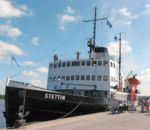.gif)
Stettin (icebreaker)
Encyclopedia
Stettin is a steam icebreaker
Icebreaker
An icebreaker is a special-purpose ship or boat designed to move and navigate through ice-covered waters. Although the term usually refers to ice-breaking ships, it may also refer to smaller vessels .For a ship to be considered an icebreaker, it requires three traits most...
built by the shipyard Stettiner Oderwerke in 1933. She was ordered by the Chamber of Commerce of Stettin (until 1945 Germany
Germany
Germany , officially the Federal Republic of Germany , is a federal parliamentary republic in Europe. The country consists of 16 states while the capital and largest city is Berlin. Germany covers an area of 357,021 km2 and has a largely temperate seasonal climate...
, since 1945 Szczecin
Szczecin
Szczecin , is the capital city of the West Pomeranian Voivodeship in Poland. It is the country's seventh-largest city and the largest seaport in Poland on the Baltic Sea. As of June 2009 the population was 406,427....
, Poland
Poland
Poland , officially the Republic of Poland , is a country in Central Europe bordered by Germany to the west; the Czech Republic and Slovakia to the south; Ukraine, Belarus and Lithuania to the east; and the Baltic Sea and Kaliningrad Oblast, a Russian exclave, to the north...
). The economy of the city of Stettin strongly depended on the free access of ships to and from the Baltic Sea
Baltic Sea
The Baltic Sea is a brackish mediterranean sea located in Northern Europe, from 53°N to 66°N latitude and from 20°E to 26°E longitude. It is bounded by the Scandinavian Peninsula, the mainland of Europe, and the Danish islands. It drains into the Kattegat by way of the Øresund, the Great Belt and...
. Therefore, icebreakers were used to keep the shipping channels free from ice during the winter.
For the first time in Germany, the construction was characterized by a new bow design called Runeberg-bow. This new bow design broke the ice using a novel method. It was not broken by the weight of the ship but by a sharp cutting edge. Future development of icebreakers was influenced by this bow form.

World War II
World War II, or the Second World War , was a global conflict lasting from 1939 to 1945, involving most of the world's nations—including all of the great powers—eventually forming two opposing military alliances: the Allies and the Axis...
.
With the special hull design and an engine power with a maximum horsepower of 2200, measured at the cylinders, Stettin was able to break ice up to a thickness of half a meter, at a constant speed of one to two knots. Thicker ice could only be broken by boxing. Boxing was a process in which the ship ran several attacks until the ice gave way.
From 1933 to 1945, Stettin was used on the Oder River between Stettin and Swinemünde (Świnoujście
Swinoujscie
Świnoujście is a city and seaport on the Baltic Sea and Szczecin Lagoon, located in the extreme north-west of Poland. It is situated mainly on the islands of Uznam and Wolin, but also occupies smaller islands, of which the largest is Karsibór island, once part of Usedom, now separated by a Piast...
), as well as on the Baltic Sea, in Kriegsmarine
Kriegsmarine
The Kriegsmarine was the name of the German Navy during the Nazi regime . It superseded the Kaiserliche Marine of World War I and the post-war Reichsmarine. The Kriegsmarine was one of three official branches of the Wehrmacht, the unified armed forces of Nazi Germany.The Kriegsmarine grew rapidly...
service.
On the night of 8 April 1940, Stettin participated in the capture of Copenhagen
Battle of Denmark
The Battle of Denmark was the fighting that followed the German army crossing the Danish border on 9 April 1940 by land, sea and air. The German ground campaign against Denmark was the briefest on record in military history.-Motivation for invading Denmark:...
by participating in a surprise landing of German troops in Copenhagen together with the railway ferry/minelayer Hansestadt Danzig.
Stettin is also one of two or three surviving vessels of the east Prussia evacuation fleet
Operation Hannibal
Operation Hannibal was a German military operation involving the evacuation by sea of German troops and civilians from Courland, East Prussia, and the Polish Corridor from mid-January to May, 1945 as the Red Army advanced during the East Prussian and East Pomeranian Offensives and subsidiary...
.
From 1945 on, she was used by the waterway and navigation authorities in Hamburg on the river Elbe
Elbe
The Elbe is one of the major rivers of Central Europe. It rises in the Krkonoše Mountains of the northwestern Czech Republic before traversing much of Bohemia , then Germany and flowing into the North Sea at Cuxhaven, 110 km northwest of Hamburg...
.
In 1981, Stettin was slated to be scrapped due to uneconomic costs. With the establishment of a development association, thousands of working hours, and support by generous sponsors, the ship was saved. Today, she is a technical culture monument. Her homeport is the museum port of Oevelgoenne in Hamburg
Hamburg
-History:The first historic name for the city was, according to Claudius Ptolemy's reports, Treva.But the city takes its modern name, Hamburg, from the first permanent building on the site, a castle whose construction was ordered by the Emperor Charlemagne in AD 808...
, Germany. During summertime, Stettin cruises with guests on occasions like "Hamburg port birthday," "Hansesail Rostock," and "Kieler Woche," and is also used as a charter vessel.

